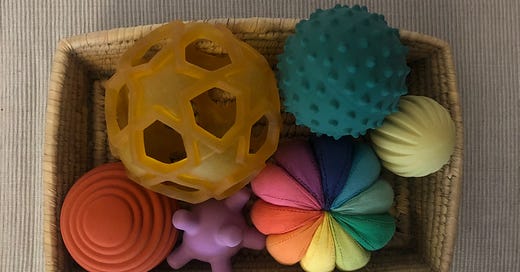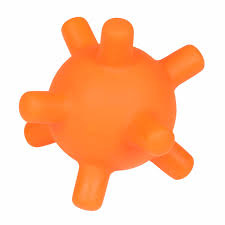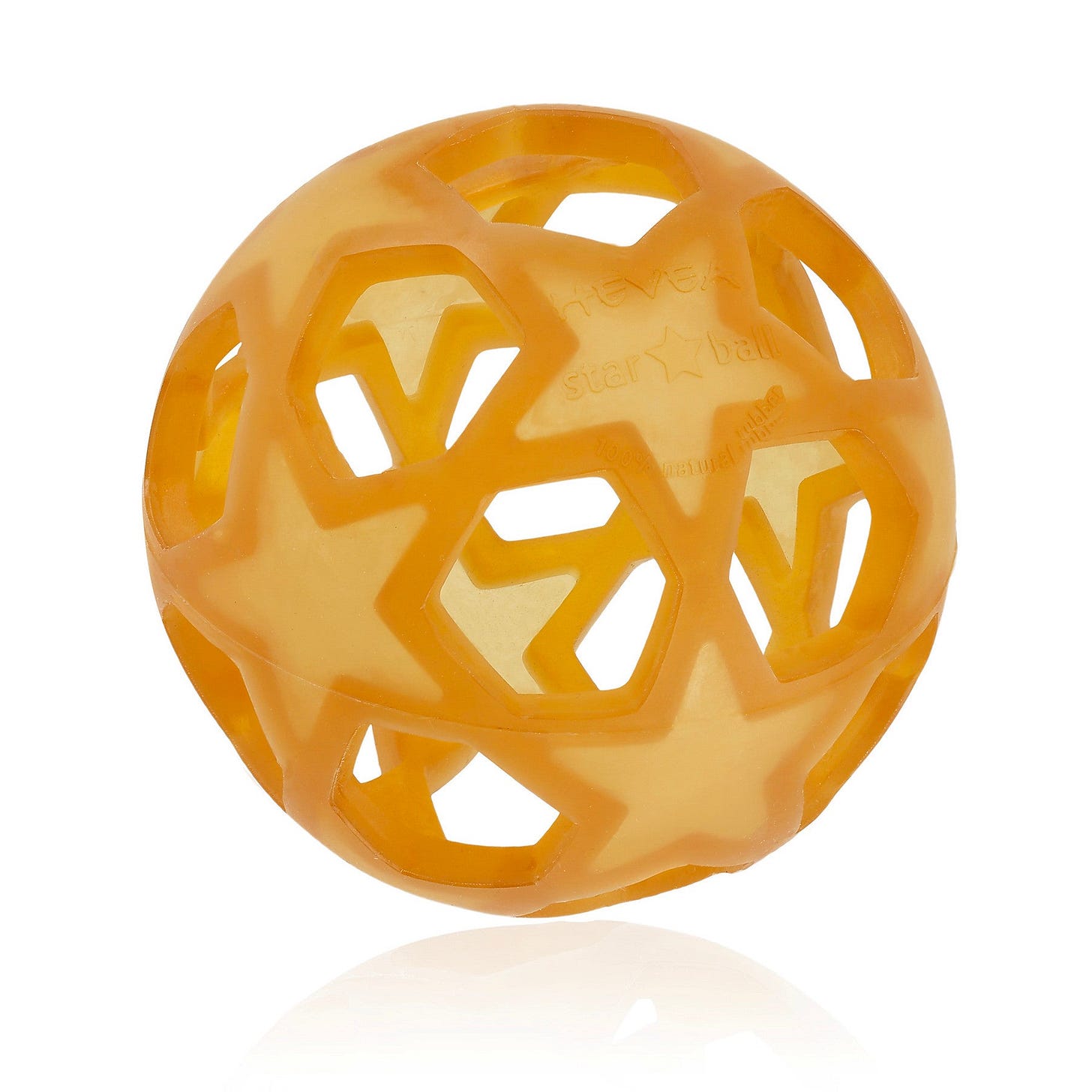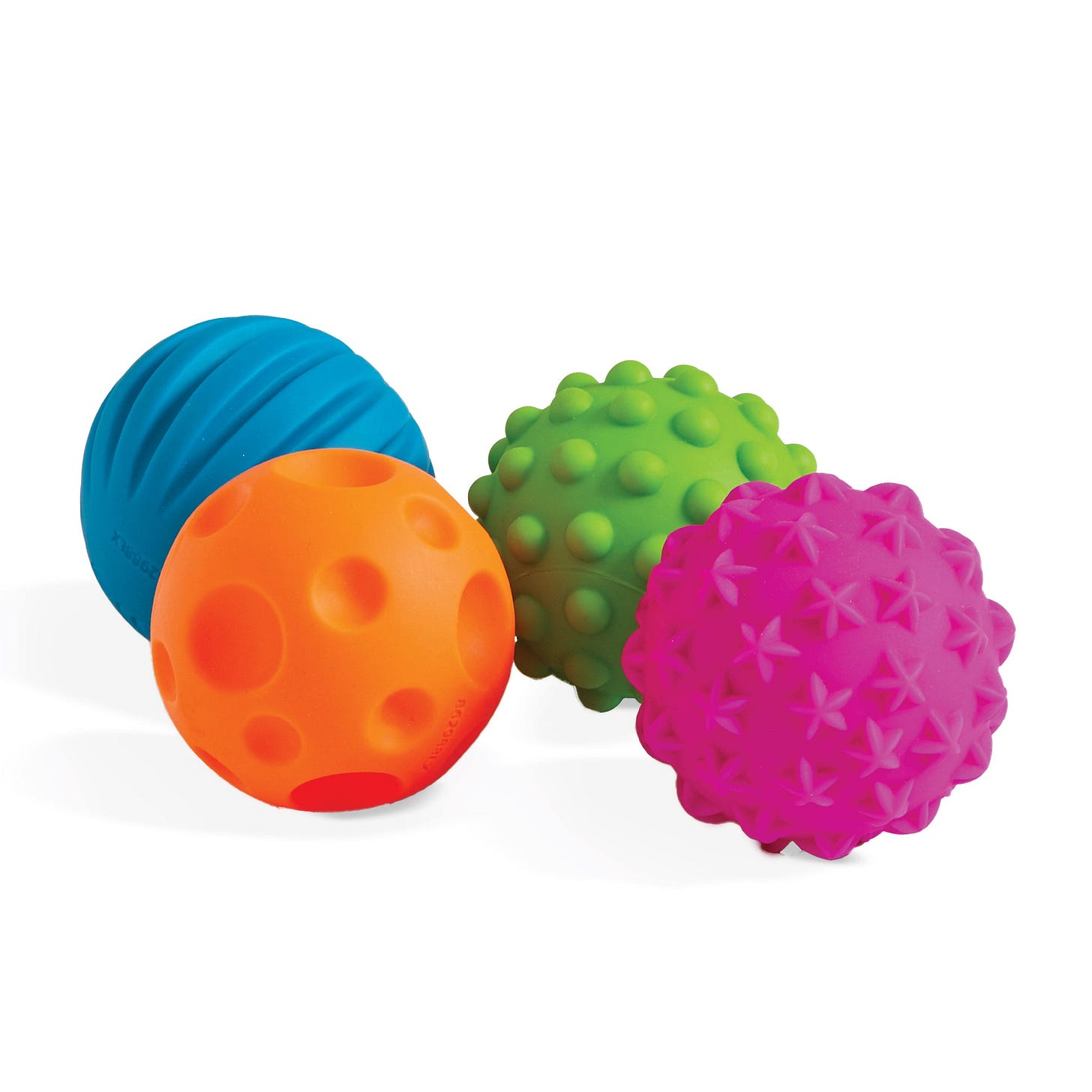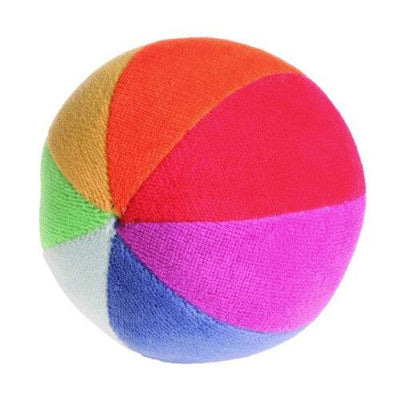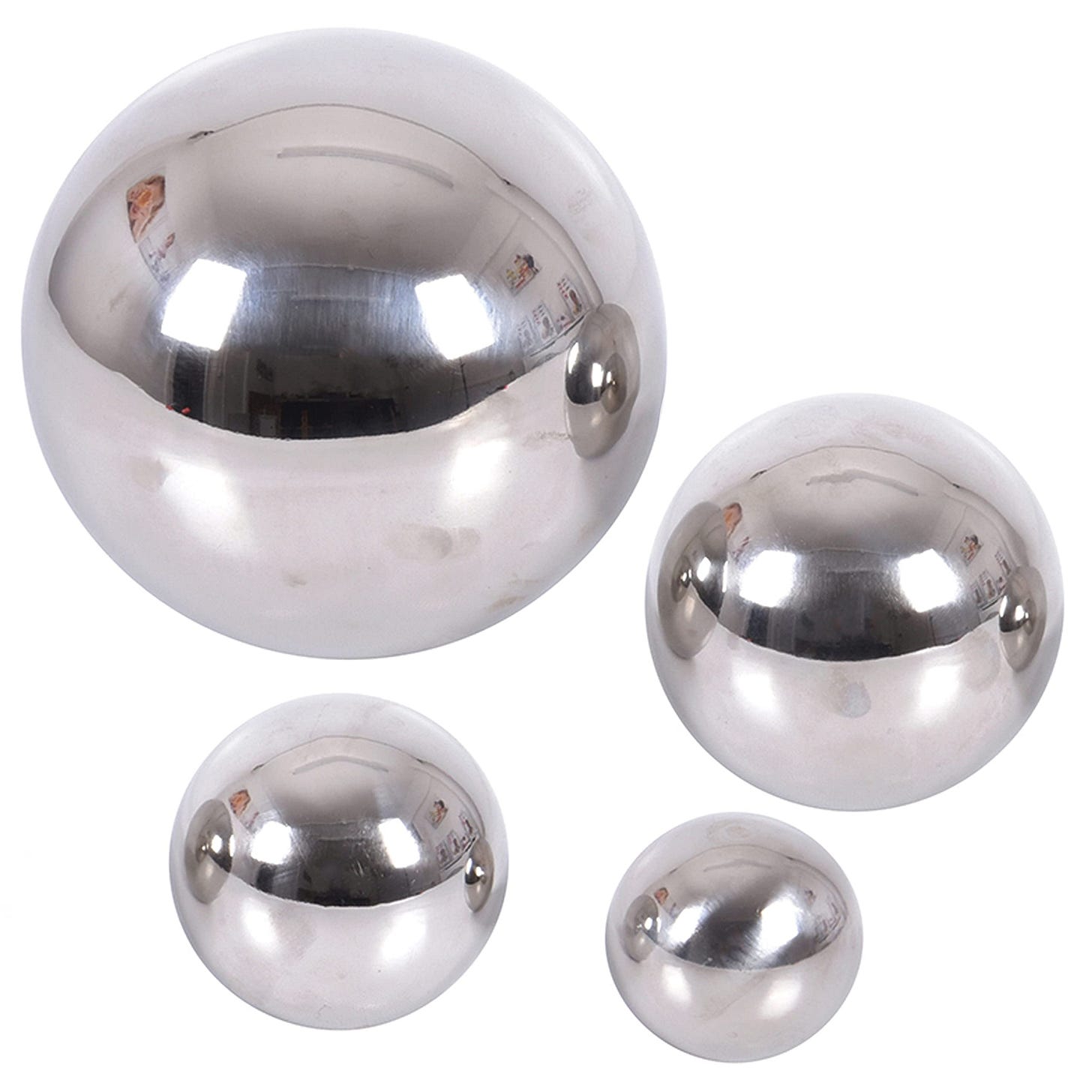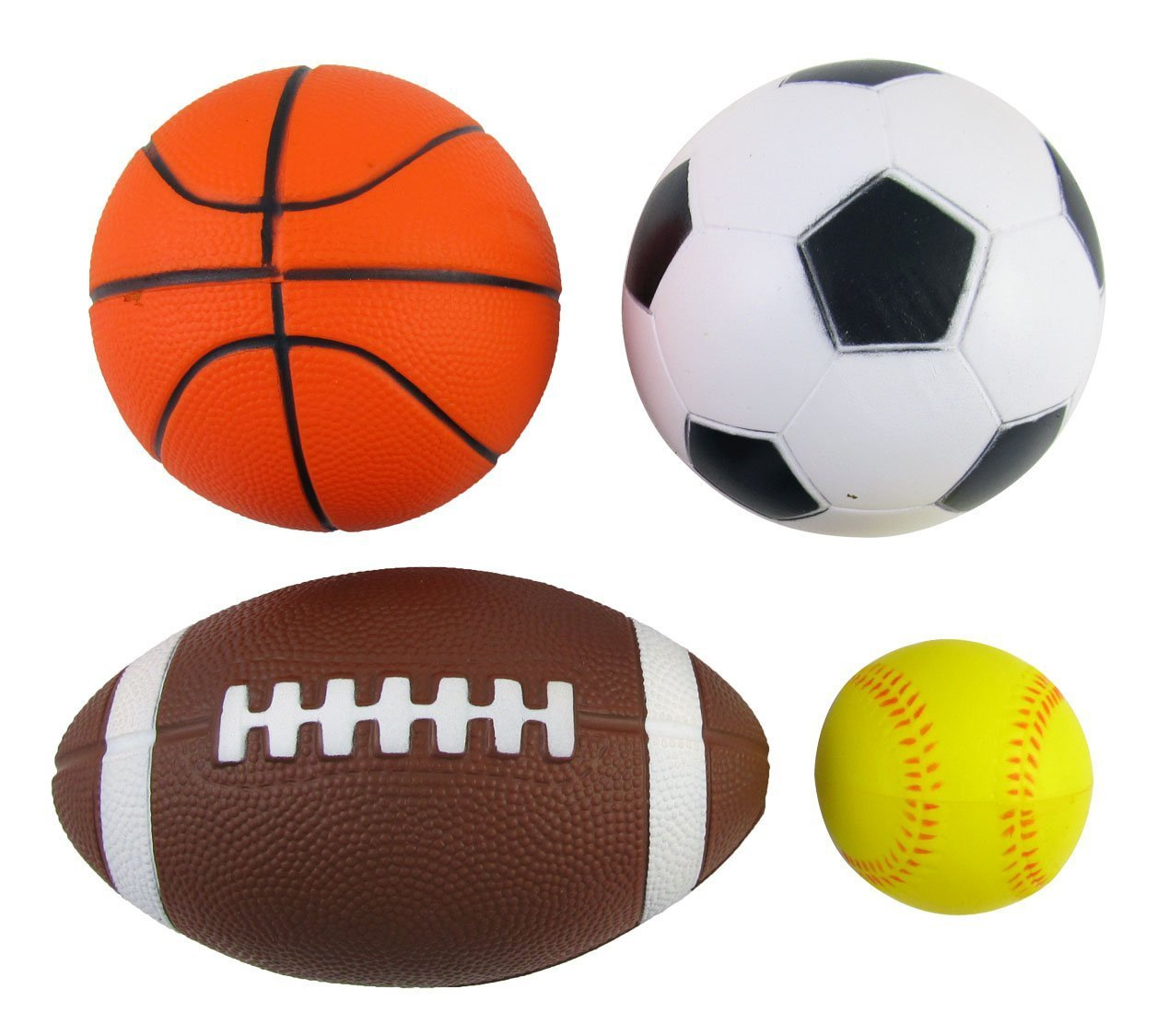Balls are amazing toys for babies, toddlers… and all ages. If you’re a parent you probably own multiple, but maybe you don’t know that not all balls are created equal. Small details will make certain options better for certain stages of development. Let’s look at a few styles of ball and how they might be used as your baby grows.
Teething ball
This ball is great for babies who are beginning to reach for and grasp objects, as its surface is covered in little nubs their fingers can hold onto. The rubbery material has some give, and the size is small so it fits well in a tiny palm. As the name says, however, the thing this ball is best for is teething, as the nubs can be sucked or chewed on by the baby. If a baby who is still pre-mobile lets go this ball, its shape practically guarantees that it can’t roll away very far, which is perfect for the stage where they still aren’t able to crawl after it.
Some examples here are the Nienhuis teething ball (plastic rubber) and the Filibabba motor ball (natural rubber).
Open balls
Balls with open sides are fantastic. First of all, they are so easy to grab and hang onto because there’s lots of holes that babies can hook their fingers into. Secondly, they allow for interesting variations where you place a smaller ball (if the material is flexible), or “trap” some fabric inside that babies will want to pull and tug on. You can also experiment with “trapping” different toys and objects inside them. The fact that they’re so hole-y also means they’re super light, making it great for younger babies.
Some examples here are the famous Bright Starts Oball (BPA-free plastic), the OggoBolli teether (silicone), Hevea star ball (natural rubber), the Calmies teether (natural rubber), the Pikler ball (reed pith) and the Skwish rattle (wood). The Skwish and Oggobolli aren’t technically balls as they’re not spherical, which makes them better for pre-mobile babies, as they don’t tend to roll away as easily. The other options are better for babies who are already crawling or walking.
Textured balls
These have a textured surface, and for that they’re often called “sensory balls”. I don’t love this terminology because frankly every object that’s meant to be manipulated is sensory - it communicates sensory information about size, color, texture, weight, temperature, sound and smell to babies. Textured balls are a bit more of a challenge and they will roll away more easily than the teething ball, so they would be ideal for a baby who is learning to creep and crawl.
For this I love the Miniland ball set (natural rubber) which also includes a teething rubber such as the ones mentioned above, and the Caaocho rainbow ball (natural rubber). There are also many sets in a harder plastic, such as this.
Fabric balls
Fabric balls can be made of crochet yarn or sewn from fabric, and are usually filled with soft, squishy batting material like wool or polyfill. Small round balls are great for babies who are learning to grasp with one hand - they will mold into the hand when squished, instead of slipping away, and they won’t roll too far from the baby. Later, they are also excellent for practicing with an object permanence box where the hole is slightly smaller, as the baby will have to push the fabric with their hands to make it go into the box.
Some examples are the Grimms ball (cotton) or a set of dryer balls (wool).
A larger fabric ball with wedge-shaped sections will be easier to manipulate with both hands, and can be used also for kicking, throwing and catching. These balls are often called Montessori balls, Takane balls, Puzzle balls or Kicking balls. They usually have a bell attached to them, which helps babies develop auditory tracking and provides feedback when the ball is moved.
One example is the Nienhuis kicking ball (cotton).
Reflective balls
Balls with a mirrored surface are very smooth and can be heavy, so they’re better for older babies who are confidently crawling or walking. They are so interesting to look at because they reflect everything around them sort of like a fisheye lens. Babies love them because they like shiny objects, they are intrigued looking at their face and their fingers as they reach for them, and because they’re cold and smooth which is a nice sensory variation.
One example is the Tickit reflective ball set (stainless steel).
Wooden balls
Balls made of solid wood are heavy and smooth, so they need to be handled carefully otherwise they make a loud sound when falling on a hard floor. They also roll away very fast, and easily slip out of their hands, so they also present a challenge.
Because the weight requires more control of the hands and because the sound is a clear, rewarding feedback signal for the baby, in Montessori we use solid wooden balls in materials such as the ball-push box and the ball tracker.
Balls for toddlers
Toddlers who are learning to run, jump, throw and catch want balls that bounce higher and move faster, for more challenging play by themselves or with others. They also like balls that resemble the ones they see being used out in the world.
Some examples of bouncy balls are the Waboba moon ball (polyurethane) or small pilates/ exercise balls (PVC). These are also great fun if only partially inflated. A big yoga ball (PVC) or bouncing ball (PVC) can also be lots of fun, and excellent gross motor stimulation. Because it’s hard to find bouncy balls in non-toxic materials, I’d recommend keeping these away from babies who still bring most objects to their mouth.
Soccer, basketball or volleyball balls are great for toddlers who are more advanced in kicking, throwing and catching. If your toddler is interested in starting to play these sports with you, look for a smaller version that matches their size, so they can be successful - such as these.
The perfect toy
… doesn’t exist. But if it did exist, I’d say it’s a ball. It can be such a simple object, and yet it opens up an entire world of play and possibilities for people of all ages. I think balls like the ones I mentioned above are a great investment when it comes to baby toys, because they can be used during *pretty much* your child’s whole childhood - as teethers, things to crawl after, things to throw and catch, loose parts, fidgets and more. They always have something to offer in all developmental stages!
I’ve been having fun breaking down materials for babies here on Substack. I’ve covered visual mobiles, tactile mobiles, puzzles and now balls. Let me know what other materials you’d like to see a deeper dive on, and subscribe to see new posts:

